

Belle Grove Historic District
Covering 22 city blocks, the
Belle Grove Historic District in
Fort Smith, Arkansas, spans
130 years of architectural
history.
Covering 22 city blocks, the
Belle Grove Historic District in
Fort Smith, Arkansas, spans
130 years of architectural
history.
ExploreSouthernHistory.com - Belle Grove Historic District in Fort Smith, Arkansas
ExploreSouthernHistory.com - Belle Grove Historic District in Fort Smith, Arkansas

| Belle Grove Historic District Now the Fort Smith Art Center, this home in the city's Belle Grove Historic District quartered troops during the Civil War. |

Casper Reutzel House
Built in 1850, the Reutzel
House was loopholed for
musket fire and survived the
Civil War.
Built in 1850, the Reutzel
House was loopholed for
musket fire and survived the
Civil War.

Bonneville House
Built in 1870, the historic
Bonneville House was the
home of the widow of famed
Western explorer, General
Benjamin Bonneville.
Built in 1870, the historic
Bonneville House was the
home of the widow of famed
Western explorer, General
Benjamin Bonneville.


John Rogers House
The oldest home in Fort
Smith, the John Rogers
House was modeled after the
quarters of the military post
itself.
The oldest home in Fort
Smith, the John Rogers
House was modeled after the
quarters of the military post
itself.
Belle Grove Historic District - Fort Smith, Arkansas
22 Blocks of Arkansas History!
When the U.S. Army established Fort Smith
on the western border of Arkansas in 1817, it
signaled a new westward expansion of the
American frontier. It did not take long for a
community to spring up beside the fort and
before long the City of Fort Smith became a
major center for commerce and trade.
As the community grew and prospered, an
impressive residential neighborhood
developed along its north side. Beautifully
preserved today, the Belle Grove Historic
District offers a fascinating look back through
time to the days when Fort Smith was a
jumping for those heading west in the
California Gold Rush and the seat of justice
for the "hanging judge," Isaac C. Parker.
Among the beautiful and historic structures
dotting the 22 blocks of the district is the
John Rogers House. Modeled after the
quarters of the old fort itself, the unique brick
home was built in the 1840s and is thought
to be the oldest still standing in Fort Smith. It
survived the turbulent years of the Civil War
and stands at 400 North Eighth Street. Not
open to the public.
Nearby, at 423 North Fifth Street, stands the
Casper Reutzel House. Built in around 1850,
it was constructed using a unique half-timber
and brick nogging technique. Reutzel, who
had immigrated to the United States from
Germany, was the owner of the largest cotton
shipping firm on the Arkansas River. Another
survivor of the Civil War years, the walls of the
home are pierced for loopholes to allow the
inhabitants to fire on attackers. Not open to
the public.
Just one block over at 423 North Sixth Street
is a home that now serves as the Fort Smith
Art Center. Completed in 1857 by Ethelbert
Bright, it clearly reflects the changing style
and growing prosperity of Fort Smith in the
years leading up to the Civil War. Built in the
Victorian Second Empire style, the Art Center
was used as a barracks for soldiers during
the Civil War. It now contains outstanding art
galleries. Please click here to read more
about the Fort Smith Art Center and see
current open hours.
Up the street at 514 North Sixth is the Clayton
House. Built during the 1850s but enlarged
and extensively remodeled in 1882, this was
the home of William Henry Harrison Clayton
who served as U.S. Attorney for the Western
District of Arkansas during the tenure of
Isaac C. Parker, the famed "hanging judge"
of Fort Smith. Please click here to learn more
and check for current open hours.
At 318 North Seventh Street is the stunning
Bonneville House. Built in around 1870 in the
Victorian Renaissance style, the home was
purchased in 1878 by Susan Bonneville, the
widow of General Benjamin Bonneville. A
native of France and graduate of the U.S.
Military Academy at West Point, Bonneville
served in both the Mexican and Civil Wars.
He was best known, however, as an intrepid
explorer who led numerous early expeditions
across the Old West. He died before the
family could occupy the house, but his wife
lived there for many years. Please click here
to learn more.
on the western border of Arkansas in 1817, it
signaled a new westward expansion of the
American frontier. It did not take long for a
community to spring up beside the fort and
before long the City of Fort Smith became a
major center for commerce and trade.
As the community grew and prospered, an
impressive residential neighborhood
developed along its north side. Beautifully
preserved today, the Belle Grove Historic
District offers a fascinating look back through
time to the days when Fort Smith was a
jumping for those heading west in the
California Gold Rush and the seat of justice
for the "hanging judge," Isaac C. Parker.
Among the beautiful and historic structures
dotting the 22 blocks of the district is the
John Rogers House. Modeled after the
quarters of the old fort itself, the unique brick
home was built in the 1840s and is thought
to be the oldest still standing in Fort Smith. It
survived the turbulent years of the Civil War
and stands at 400 North Eighth Street. Not
open to the public.
Nearby, at 423 North Fifth Street, stands the
Casper Reutzel House. Built in around 1850,
it was constructed using a unique half-timber
and brick nogging technique. Reutzel, who
had immigrated to the United States from
Germany, was the owner of the largest cotton
shipping firm on the Arkansas River. Another
survivor of the Civil War years, the walls of the
home are pierced for loopholes to allow the
inhabitants to fire on attackers. Not open to
the public.
Just one block over at 423 North Sixth Street
is a home that now serves as the Fort Smith
Art Center. Completed in 1857 by Ethelbert
Bright, it clearly reflects the changing style
and growing prosperity of Fort Smith in the
years leading up to the Civil War. Built in the
Victorian Second Empire style, the Art Center
was used as a barracks for soldiers during
the Civil War. It now contains outstanding art
galleries. Please click here to read more
about the Fort Smith Art Center and see
current open hours.
Up the street at 514 North Sixth is the Clayton
House. Built during the 1850s but enlarged
and extensively remodeled in 1882, this was
the home of William Henry Harrison Clayton
who served as U.S. Attorney for the Western
District of Arkansas during the tenure of
Isaac C. Parker, the famed "hanging judge"
of Fort Smith. Please click here to learn more
and check for current open hours.
At 318 North Seventh Street is the stunning
Bonneville House. Built in around 1870 in the
Victorian Renaissance style, the home was
purchased in 1878 by Susan Bonneville, the
widow of General Benjamin Bonneville. A
native of France and graduate of the U.S.
Military Academy at West Point, Bonneville
served in both the Mexican and Civil Wars.
He was best known, however, as an intrepid
explorer who led numerous early expeditions
across the Old West. He died before the
family could occupy the house, but his wife
lived there for many years. Please click here
to learn more.
The Belle Grove Historic District is also the
location of another home associated with an
American military hero. The Darby House at
311 General Darby Street (North Eighth) was
the home of General William O. Darby, the
father of the modern U.S. Army Rangers.
A heroic commander during World War II,
Darby founded "Darby's Rangers," a unit
specially trained for night fighting, operating
behind enemy lines and spearheading Allied
attacks. He received the Purple Heart, Silver
Star and Distinguished Service Cross and
was the only soldier in World War II to be
honored with the British Distinguished
Service Order, French Croix de Guerre and
Soviet Order of Kutuzov. He was killed in
action in Italy in 1945 at the age of 33.
General Darby is buried nearby at Fort Smith
National Cemetery and his boyhood home
now holds a museum that pays tribute to his
life and service. The museum also displays
a collection of Rangers' memorabilia. Please
call (479) 782-3388 for open hours.
The Belle Grove Historic District is home to
many other restored structures and can be
visited daily. It is bounded by North Fifth,
North "H", North Eighth and North "C" Streets.
Please click here to view a map of the Belle
Grove Historic District in Fort Smith.
location of another home associated with an
American military hero. The Darby House at
311 General Darby Street (North Eighth) was
the home of General William O. Darby, the
father of the modern U.S. Army Rangers.
A heroic commander during World War II,
Darby founded "Darby's Rangers," a unit
specially trained for night fighting, operating
behind enemy lines and spearheading Allied
attacks. He received the Purple Heart, Silver
Star and Distinguished Service Cross and
was the only soldier in World War II to be
honored with the British Distinguished
Service Order, French Croix de Guerre and
Soviet Order of Kutuzov. He was killed in
action in Italy in 1945 at the age of 33.
General Darby is buried nearby at Fort Smith
National Cemetery and his boyhood home
now holds a museum that pays tribute to his
life and service. The museum also displays
a collection of Rangers' memorabilia. Please
call (479) 782-3388 for open hours.
The Belle Grove Historic District is home to
many other restored structures and can be
visited daily. It is bounded by North Fifth,
North "H", North Eighth and North "C" Streets.
Please click here to view a map of the Belle
Grove Historic District in Fort Smith.
Fort Smith - Area Historic Sites
Fort Smith - Downtown Historic Sites
General William O. Darby of Fort Smith
Fort Smith National Historic Site
Fort Smith National Cemetery
Hanging Judge Isaac C. Parker
Historic Oak Cemetery
Battle of Massard Prairie
Battle of Fort Smith
Historic Sites of Arkansas
Explore other Southern Historic Sites
Fort Smith - Downtown Historic Sites
General William O. Darby of Fort Smith
Fort Smith National Historic Site
Fort Smith National Cemetery
Hanging Judge Isaac C. Parker
Historic Oak Cemetery
Battle of Massard Prairie
Battle of Fort Smith
Historic Sites of Arkansas
Explore other Southern Historic Sites
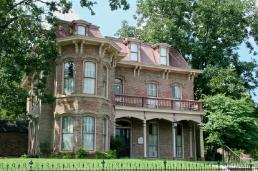
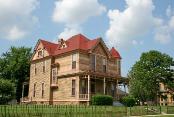
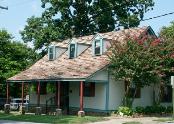
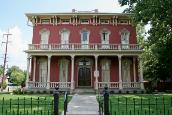
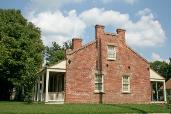

Custom Search
| Copyright 2010 by Dale Cox All rights reserved. |